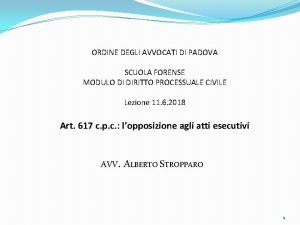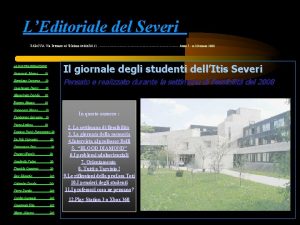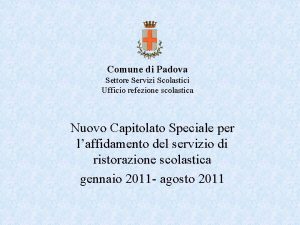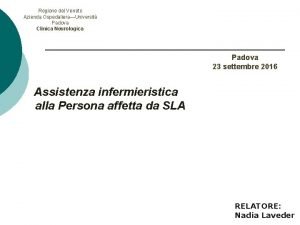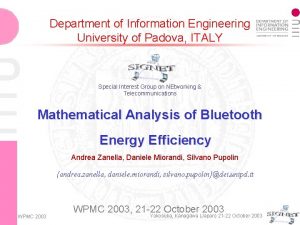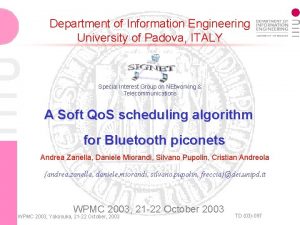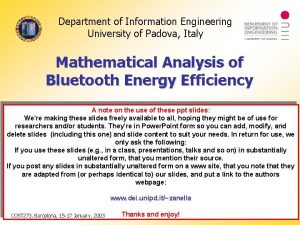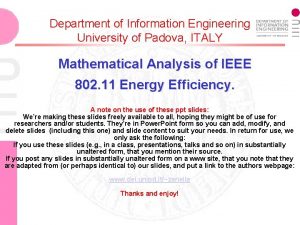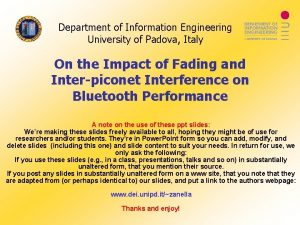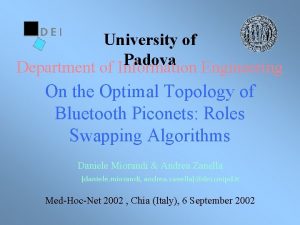University of Padova Department of Information Engineering On













- Slides: 13

University of Padova Department of Information Engineering On the Optimal Topology of Bluetooth Piconets: Roles Swapping Algorithms A note on the use of these ppt slides: We’re making these slides freely available to all, hoping they might be of use for researchers and/or students. They’re in Power. Point form so you can add, modify, and delete slides (including this one) and slide co ntent to suit your needs. In return for use, we only ask the following: If you use these slides (e. g. , in a class, presentations, talks and so on) in substantially unaltered form, that you mention their source. If you post any slides in substantially unaltered form on a www site, that you note that they are adapted from (or perhaps identical to) our slides, and put a link to the authors webpage: www. dei. unipd. it/~zanella Thanks and enjoy!

University of Padova Department of Information Engineering On the Optimal Topology of Bluetooth Piconets: Roles Swapping Algorithms Med-Hoc-Net 2002 , Chia (Italy), 6 September 2002

Overview Intro to Bluetooth system Mathematical model Stability issues & delay analysis Optimal criterion for off-line topologies design Suboptimal criterion for real-time network reconfiguration Conclusion & discussion D. Miorandi & A. Zanella Med-Hoc-Net, Chia, 6 September 2002

Background: BT system architecture Two up to eight active Bluetooth devices sharing the same FH channel form a piconet. In each piconet, a unit acts as a master, the others act as slaves. Channel access is based on a centralized polling scheme. Full duplex is achieved by means of time division duplexing (TDD). D. Miorandi & A. Zanella Med-Hoc-Net, Chia, 6 September 2002

System Model Cluster of N+1 nodes (N 7) Assumptions All nodes are in-range Independent Poisson traffic model Definitions Δ={δi, j}: End-to-end traffic matrix Λ={λi, j}: Effective traffic pattern matrix k: master unit P={k, Δ}: piconet D. Miorandi & A. Zanella Med-Hoc-Net, Chia, 6 September 2002

System Model (2) Stability condition for the PRR polling scheme: Definition: A traffic matrix is admissible if there is a master choice k s. t. the stability condition holds (i. e. there is a stable topology). Definition: A traffic matrix is fully admissible if the stability conditions hold for any choice of the master k. Proposition: A traffic matrix following conditions hold: is fully admissible if and only if the Proposition: A traffic matrix following conditions hold: is admissible if and only if the D. Miorandi & A. Zanella Med-Hoc-Net, Chia, 6 September 2002

Optimal Criterion Average link delay: Average packet delay Total offered traffic Average network delay Criterion I: choose k s. t. D. Miorandi & A. Zanella Med-Hoc-Net, Chia, 6 September 2002

Suboptimal Criterion Effective offered traffic: Reasoning: The more the effective traffic, the closer we get to the stability limit. The closer to the stability limit, the higher the delay. Criterion II: choose k s. t. D. Miorandi & A. Zanella Med-Hoc-Net, Chia, 6 September 2002

Results (1) At medium-to-high loads, both criterion offer a remarkable performance improvement. The suboptimal criterion leads to good results, even if far from optimality. [N=5, matrix entries uniformly distributed in (0, 1)] D. Miorandi & A. Zanella Med-Hoc-Net, Chia, 6 September 2002

Results (2) The delays are significantly higher in the sparse case. Both criterion offer valuable performance improvement. [N=5, matrix entries uniformly distributed in (0, 1), average density of 0. 4] D. Miorandi & A. Zanella Med-Hoc-Net, Chia, 6 September 2002

Applications Optimal design of a static Bluetooth piconet (e. g. , sensor networks). Dynamic reconfiguration of a Bluetooth piconet: The suboptimal criterion may be used to find efficient configurations (and adapt to varying traffic conditions). Connection admission control: check for admissibility of the resulting traffic matrix. D. Miorandi & A. Zanella Med-Hoc-Net, Chia, 6 September 2002

Conclusion An analytical settlement for the characterization of efficient piconet topologies has been proposed. Two algorithms for the master choice (an optimal and a suboptimal with low computational complexity) have been presented. Simulation have been performed to show the impact on network performance. Some possible applications have been presented. Next step: towards efficient scatternet topologies. D. Miorandi & A. Zanella Med-Hoc-Net, Chia, 6 September 2002

Any Questions? D. Miorandi & A. Zanella Med-Hoc-Net, Chia, 6 September 2002
 Department of information engineering university of padova
Department of information engineering university of padova Information engineering padova
Information engineering padova Narrativistic
Narrativistic Information engineering padova
Information engineering padova University of sargodha engineering department
University of sargodha engineering department 5 ic padova
5 ic padova Organigramma comune di padova
Organigramma comune di padova Scuola forense padova
Scuola forense padova Via pettinati 46 padova
Via pettinati 46 padova Introduzione al vangelo di luca
Introduzione al vangelo di luca Ringraziamenti rappresentante di classe
Ringraziamenti rappresentante di classe Iniziazione cristiana padova
Iniziazione cristiana padova Servizi scolastici padova
Servizi scolastici padova Clinica neurologica padova
Clinica neurologica padova







